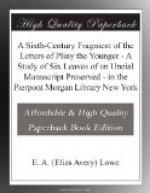As to the original from which our manuscript was copied, very little can be said. The six leaves before us furnish scanty material on which to build any theory. The errors which occur are not sufficient to warrant any conclusion as to the script of the archetype. One item of information, however, we do get: an omission on fol. 52v goes to show that the manuscript from which our scribe copied was written in lines of 25 letters or thereabout.[24] The scribe first wrote EXCUCURIS|SEM COMMEATU. Discovering his error of omission, he erased SEM at the beginning of line 8 and added it at the end of line 7 (intruding upon margin-space in order to do so), and then supplied, in somewhat smaller letters, the omitted words ACCEPTO UT PRAEFECTUS AERARI. As there are no homoioteleuta to account for the omission, it is almost certain that it was caused by the inadvertent skipping of a line.[25] The omitted letters number 25.
[Footnote 24: On the subject of omissions
and the clues they often
furnish, see the exhaustive treatise by
A.C. Clark entitled The
Descent of Manuscripts, Oxford 1918.]
[Footnote 25: Our scribe’s method is as patient as it is unreflecting. Apparently he does not commit to memory small intelligible units of text, but is copying word for word, or in some places even letter for letter.]
A glance at the abbreviations used in the index of addresses on foll. 48v-49r teaches that the original from which our manuscript was copied must have had its names abbreviated in exactly the same form. There is no other way of explaining why the scribe first wrote AD IULIUM SERUIANUM (fol. 49, l. 12), and then erased the final UM and put a point after SERUIAN.
THE DATE AND LATER HISTORY OF THE MANUSCRIPT.
Our manuscript was written in Italy at the end of the fifth or more probably at the beginning of the sixth century.
The manuscripts with which we can compare it come, with scarcely an exception, from Italy; for it is only of more recent uncial manuscripts (those of the seventh and eighth centuries) that we can say with certainty that they originate in other than Italian centres. The only exception which occurs to one is the Codex Bobiensis (k) of the Gospels of the fifth century, which may actually have been written in Africa, though this is far from certain. As for our fragment, the details of its script, as well as the ornamentation, disposition of the page, the ink, the parchment, all find their parallels in authenticated Italian products; and this similarity in details is borne out by the general impression of the whole.
The manuscript may be dated at about the year A.D. 500, for the reason that the script is not quite so old as that of our oldest fifth-century uncial manuscripts, and yet decidedly older than that of the Codex Fuldensis of the Gospels (F) written in or before A.D. 546.
[Sidenote: On the dating of uncial manuscripts]




